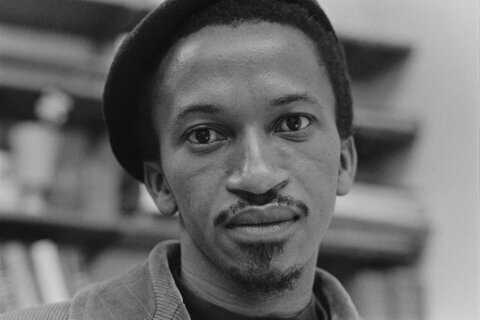KEY WEST, Fla. (AP) — Ernest Hemingway spent the 1930s in Key West, Florida, and more than six decades after his death, fans, scholars and relatives continue to congregate on the island city to celebrate the author’s award-winning novels and adventure-filled life.
Hemingway Days started in 1981 with a short-story competition and a look-alike contest. This year’s celebration concluded Sunday on the 125th anniversary of Hemingway’s birth on July 21, 1899.
As a novelist, short-story writer and journalist, Hemingway’s spot in the pantheon of American literature is undeniable and his legacy permeates the culture and character of Key West.
Hemingway’s great-grandson, Stephen Hemingway Adams, was born nearly three decades after Hemingway died. Adams said working with his grandfather, Patrick Hemingway, who was Ernest Hemingway’s second son, helped him gain a deeper understanding of his famous ancestor.
“I got to work with my granddad, and we put out a book called ‘Dear Papa,’ which was all of the letters between Ernest and my grandfather,” Adams said.
The difference between the public perception and the documented reality of Hemingway can be fuzzy. He loved big-game fishing in the Caribbean and hunting in Africa. He loved bullfighting, baseball, boxing and barhopping. But he also was a serious artist who won Pulitzer and Nobel prizes. He put so much of his life experiences into his writing that it can be tricky to separate the man from the myth.
Adams said he’s fine with some people loving the adventurer more than the writer.
“I think it’s a split, and I think that’s what’s fun,” Adams said of the throngs of look-alikes who visit Key West every year.
The Key West that Hemingway first visited in 1928 was a rustic fishing village, not a bustling tourist destination. Hemingway and his second wife, Pauline, had only planned a brief stop to pick up a car during their move from Paris to Arkansas, where Pauline’s family lived. But the car wasn’t ready and they had to wait several weeks.
Hemingway quickly made friends with local business owners and fishermen. The couple made frequent visits to the island, and Pauline’s uncle eventually bought the couple a French Colonial home on a 1.5-acre (0.61-hectare) lot in 1931.
After spending most of his 20s in Paris, Hemingway embraced the vastly different island lifestyle, according to Cori Convertito, a curator at Key West Museum of Art & History at the Custom House.
“He doesn’t come here to act like a recluse and just write,” Convertito said. “He’s out at the bars all the time. He’s out fishing with people. He’s interacting in boxing matches.”
Convertito pointed out that Hemingway was in his 30s for most of the time he lived in Key West, not the white-bearded “Papa Hemingway” most look-alike contestants emulate. “A Farewell to Arms” was finished shortly after he began visiting Key West and that book’s reception, along with his coverage of the Spanish Civil War in the late 1930s, increased his fame.
Much of Hemingway’s time in Key West was devoted to big-game fishing with friends. Convertito said Hemingway began to pioneer new techniques after getting his own boat, the Pilar, in 1934.
“He was desperate to land a fully intact marlin,” Convertito said.
The slow process of reeling in a trophy fish left them vulnerable to sharks, similar to the giant marlin caught in Hemingway’s 1952 novel, “The Old Man and the Sea.”
Hemingway focused on catching fish and removing them from the water quickly. He was an early member of the International Game Fish Association and named a vice president in 1940.
He also became an advocate for the Florida Keys and the people who lived there. “To Have and Have Not,” which was published in 1937, is set in a Key West ravaged by the Great Depression.
Hemingway was a vocal critic of how the federal government responded to the 1935 Labor Day hurricane. The official death toll was 423, but more than 250 of the fatalities were World War I veterans hired through a federal jobs program to build the Overseas Highway, which connects the Florida Keys to mainland Florida.
Hemingway drove an ambulance during World War I and felt a particular kinship with the veterans. Corey Malcom, a historian with the Florida Keys History Center, said Hemingway joined the recovery efforts and used his own boat to pull bodies out of the ocean.
Michael Morawski, CEO of the Hemingway Home & Museum, credits his great-aunt, Bernice Dixon, as one of the first people to help preserve Hemingway’s legacy in Key West. The local jewelry store owner bought the house for $80,000 in 1961, shortly after Hemingway’s death. The home became a museum in 1964 and eventually was designated a National Historic Landmark.
“The only reason that she did it was to create a living memorial to Ernest Hemingway,” Morawski said.
Besides the historical and literary significance of the home, the museum also is famous for housing the Hemingway cats. About 60 polydactyl cats with a genetic mutation for extra toes continue to live at the estate. Some of these cats are descendants of the original white, six-toed cat that Hemingway was gifted from a ship’s captain.
The Hemingway Days festival started as a promotional stunt for Sloppy Joe’s Bar, one of Hemingway’s favorite hangouts. Michael Whalton was working as a manager at the bar in 1980 when he read about a Bad Hemingway Contest, where writers parodied Hemingway’s sparse, blunt style.
Whalton decided a look-alike contest and other activities around Hemingway’s July birthday might be a great way to attract customers during the island’s slow season, when hot and humid weather scares many tourists away.
“I really didn’t know what to expect,” Whalton said. “I was getting nervous because we didn’t have anybody signed up for the look-alike contest, so I called everybody I knew in Key West who had a beard.”
The turnout was better than expected. The author’s younger brother, Leicester Hemingway, contacted Whalton and agreed to judge the look-alike contest with his wife and daughters. Whalton convinced another granddaughter of Ernest Hemingway, Lorian Hemingway, to judge a short story contest.
David Douglas, president of the Hemingway Look-Alike Society, began attending the competition in 2000 and won in 2009. The 70-year-old Houston resident continues to return every year as a judge.
“I love the contest, I love the camaraderie all the contestants,” Douglas said.
David “Bat” Masterson, of Daytona Beach, became the newest “Papa” on Saturday. The retired pilot beat out 121 others in this year’s look-alike contest.
The look-alike group has evolved over the years into a service organization with hundreds of members around the world that has funded more than $350,000 in scholarships for Florida Keys students. The organization also sponsors a youth baseball team in Cuba, where Hemingway moved after leaving Florida.
Copyright © 2024 The Associated Press. All rights reserved. This material may not be published, broadcast, written or redistributed.







